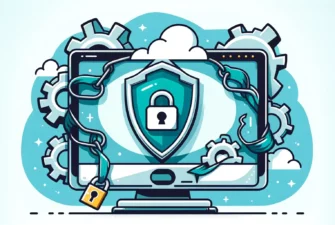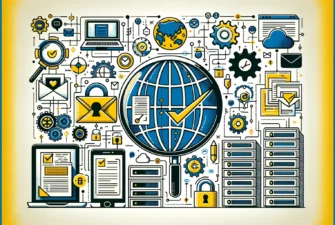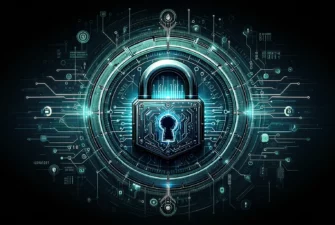
Are you looking for ways to improve web traffic security? Implementing mutual certificate authentication will significantly enhance sensitive data protection.
The two-way SSL handshake process, where both client and server validate each other’s identities, adds extra security to your web interactions.
But how does it work, and are there any downsides? This article covers everything about mutual authentication and its applications.
Table of Contents
- What Is Mutual Certificate Authentication?
- How Two-Way SSL Authentication Works?
- Advantages and Disadvantages of Mutual TLS
- When Is Mutual SSL Authentication Used?
What Is Mutual Certificate Authentication?
Mutual Certificate Authentication, often viewed as the handshake of the digital world, is a security measure where both the client and server validate each other’s identities using digital certificates. This approach ensures that data remains private and intact during transmission.
The mutual authentication process begins when a client connects to a server. The server presents its certificate to the client. This certificate, issued by a trusted third-party Certificate Authority (CA), contains the server’s public key. The client verifies this certificate against the CA’s public key. If the server’s certificate checks out, you know you’re communicating with the legitimate server, not an imposter.
But it doesn’t stop there. In mutual certificate authentication, the server also verifies your identity. You present your certificate, which the server validates against the CA’s public key. This two-way verification sets mutual certificate authentication apart from other security measures. It establishes trust in both directions, making it harder for attackers to impersonate either party.
How Two-Way SSL Authentication Works?
As you already know, mutual TLS or 2-way SSL involves both the client and server authenticating each other using SSL (Secure Sockets Layer) certificates. Let’s dissect the entire process and see what happens behind the scenes.
- Client Initiates Connection: The process begins when a client connects to a web server using HTTPS.
- Server Presents Certificate: Upon connection, the server responds by presenting its digital certificate, which includes its public key, as part of a certificate chain signed by a CA.
- Client Authentication: The client performs authentication by verifying the certificate chain using the CA certificate. This step ensures that the server’s certificate is valid and issued by a trusted authority. The client decrypts the digital signature on the server’s certificate using the CA’s public key.
- Client Certificate: In a two-way SSL authentication setup, after the server authentication, the server sends a client certificate request. In turn, the client sends the “Certificate Verify” message, which includes the client’s public key paired with the correct private key known only to the client.
- Server Authenticates Client: Upon receiving the client’s certificate, the server decrypts the digital signature on the client’s certificate using the CA’s public key. The server verifies the client’s certificate against the CA certificate, confirming its validity.
- Secure Communication Established: With both parties authenticated, a secure communication channel is established. The client and server can now communicate securely using symmetric encryption, with each party encrypting and decrypting data.
Advantages and Disadvantages of Mutual TLS
Let’s now examine the pros and cons of Mutual TLS. The heightened security it offers is a significant advantage. However, there are drawbacks to consider as well.
Two-Aay Authentication Advantages
- Enhanced Security: By validating the identities of both parties, mutual TLS authentication establishes a trust relationship, making it harder for unauthorized entities to intercept or manipulate the data transmitted. Additionally, SSL certificates add an extra layer of security as they are issued by trusted certificate authorities, confirming the authenticity of the communicating entities.
- Non-Repudiation: Another advantage of mutual TLS authentication is its ability to provide non-repudiation, ensuring that neither party can deny their involvement in a transaction. Each party’s digital certificate contains a private key to sign exchanged data, creating cryptographic proof of the sender’s identity. In case of a dispute, these digital signatures verify data origin and integrity, preventing transaction repudiation. This feature is crucial in financial dealings or legal agreements where accountability and audit trails are vital.
- Streamlined Identity Management: Mutual TLS authentication simplifies identity verification. Each party has a unique certificate containing a public key, eliminating the need for complex username/password systems. This approach reduces the risk of unauthorized access due to weak passwords and eliminates the need for centralized identity management systems. By leveraging digital certificates, mutual TLS authentication enhances efficiency and security in managing user identities.
Two-Way Authentication Advantages Disadvantages
- Complexity and Management Overhead: Implementing 2-way SSL may require additional management efforts. Tasks like generating, distributing, and revoking digital certificates and maintaining infrastructure like certificate authorities and CRLs contribute to this intricacy. Managing certificate lifecycles and checking certificate revocation status, including renewal and expiration, requires careful coordination to prevent communication disruptions. Organizations may need to allocate extra resources and expertise, increasing operational costs.
- Dependency on PKI Infrastructure: Mutual TLS authentication relies on a Public Key Infrastructure (PKI) for managing digital certificates and ensuring trust. This introduces a single point of failure, as any issue in the PKI can impact authentication and overall security. Managing and securing the PKI adds administrative burden and vulnerability. Robust PKI management and redundancy measures will mitigate dependency risks and ensure authentication integrity.
- Configuration Complexity: Two-way SSL authentication can be complex to set up and manage, especially when integrating with existing systems or applications. Configuring mutual TLS involves setting up certificates, configuring trust stores, and ensuring compatibility with various platforms and libraries. This complexity can lead to errors in configuration, potentially causing authentication failures or security vulnerabilities.
When Is Mutual SSL Authentication Used?
You might wonder what’s the best use for mutual SSL authentication. Examples include online banking systems, government document exchange portals, and healthcare applications for patient data protection. Let’s check them out.
Online Banking Systems
In online banking systems, mutual TLS authentication secures communication between users and the bank’s servers. When users access their online banking portals or mobile apps, 2-way TLS authentication verifies both parties before they exchange any sensitive information.
For instance, during login, the user’s device validates the bank’s server using its digital certificate while presenting its own cert to confirm identity. This mutual verification establishes a trusted connection, ensuring secure transactions like funds transfers and account management.
Throughout a user’s session on the online banking platform, mutual TLS authentication continues to validate identities, maintaining the integrity and confidentiality of exchanged data. This rigorous authentication process safeguards sensitive financial information like account balances and transaction history from unauthorized access or tampering. As a result, users can conduct their online banking activities with confidence.
Government Portals for Secure Document Exchange
When individuals access government portals, mutual TLS authentication verifies both parties’ identities. For example, when a user submits documents, their device authenticates the government server using its digital certificate and presents its own certificate. This mutual verification ensures that only authorized users can exchange documents with government agencies.
Mutual TLS authentication continuously validates user and government server identities, safeguarding documents from unauthorized access or tampering during transmission. By using 2-way SSL, public portals ensure the confidentiality, integrity, and authenticity of exchanged documents, fostering trust between citizens and government entities.
Healthcare Applications for Patient Data Confidentiality
Two-way SSL authentication is indispensable in healthcare applications. In addition to ensuring patient data confidentiality, this protocol offers a multifaceted approach to protecting sensitive information. Such trust is essential in healthcare settings, where patient data privacy is non-negotiable.
Beyond the initial verification of client and server identities, mutual SSL authentication employs advanced encryption techniques to protect data during transmission. This encryption, often based on industry-standard algorithms like AES (Advanced Encryption Standard), adds an extra layer of security, making it extremely difficult for unauthorized parties to intercept.
Furthermore, mutual SSL authentication facilitates seamless integration with existing healthcare systems and compliance with regulatory standards such as HIPAA (Health Insurance Portability and Accountability Act) in the United States. By adhering to these regulations, healthcare applications can confidently handle sensitive patient data while avoiding legal repercussions and breaches.
Bottom Line
So, you’ve grasped the essence of mutual SSL certificate authentication. It’s a secure handshake between two communicating systems, confirming both parties are who they claim to be.
Sure, it has pros and cons, but it’s a reliable security method used in various situations. Next time you’re dealing with sensitive data transmission, remember – two-way SSL could be your best line of defense.
Save 10% on SSL Certificates when ordering today!
Fast issuance, strong encryption, 99.99% browser trust, dedicated support, and 25-day money-back guarantee. Coupon code: SAVE10



























